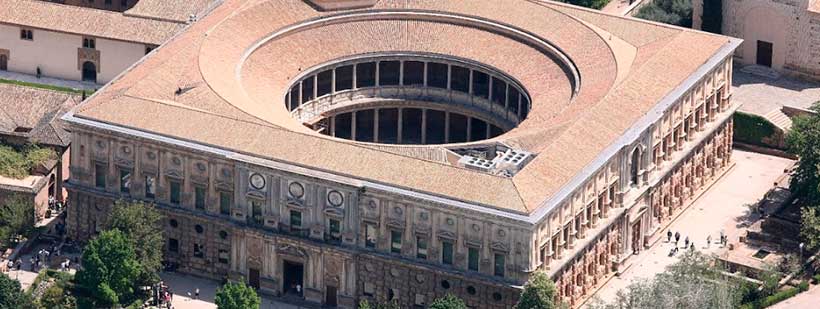CHARLES V PALACEHistory & Culture

The origin of the Palace of Charles V is due to the need for a place that met all the comforts of the time for the emperor and his family, as the Alcázar, which was his summer residence, did not cover their needs.
The emperor ordered the construction of the palace next to the Alhambra in order to enjoy its wonders. The architect in charge of the work was Pedro Machuca, a lover of Renaissance proven experience. Construction of the palace began in 1527 and financed entirely in 1957. The building went through several stages, lack of funds, revolts that stopped the works, and so on. The ceilings came to sink by default.
The palace is square, with a facade of 63 meters wide by 17 meters high. It emphasizes its circular center, unique in its style courtyard and the most outstanding work of the Renaissance in Spain. They are only decorated the south and west facades in full. The north and east only partly because the building is attached to the Palace of the Alhambra.
History of the Palace of Charles V
Already owner of America, Emperor Charles V moved his court to the royal houses of the Alhambra, to spend on them the summer of 1526. Then he was born in the Emperor's desire to make Granada one of its points of residence, so he planned to build a new palace with more comfort and more space than Arabic, but connected to it to continue to enjoy it, thereby continuing the work -the started by their grandparents Reyes Catholics, and the desire to turn this great courtly palace in the center of the Empire. That was indeed one of the finest Renaissance works that are outside Italy and the first major royal palace of the Spanish monarchs.
It was Don Luis Hurtado de Mendoza, who sought the funds to cover the project: taxes to be paid by the Moors in exchange for keeping some of their customs. Later they had sought other resources from the Alcázar of Seville and Granada sugars. The work was commissioned in 1527 the architect and painter Pedro Machuca Toledo, an artist who had trained in Italy with Michelangelo, assuming his main work for him. After his death on June 4, 1550, it was entrusted with numerous architects, some as important as Juan de Orea, played by the work of the Cathedral of Granada, and Juan de Minjares, rigger palaces of Aranjuez and El Escorial .
The building, stonework, is square, measuring 63 m. 17,40 length and height in the main facades, being inscribed inside its circular courtyard, which determines a strange and difficult to use plant, built unprecedented. It is linked to the Arab Alcázar, so they are only decorated the southern and western facades of the North and only one half of the other. The building consists of two bodies: the bottom of Tuscan order, pillowed work with and very outgoing chopped ashlar pilasters in which large bronze anillones are inserted to tie the horses. In the interstices of the pilasters rectangular windows open and above them, other circular (recently glazed), meaning along a broad poyo this body that forms the base of the palace.
Similar provision void and pilasters offers the second body, although it is much more ornate and in it, under the circular windows, balconies open with decorated lintels. The pilasters are Ionic, Corinthian entablature support.
The central part of the two main facades occupy magnificent marble covers Sierra Elvira, who are the most beautiful of the Spanish Renaissance. The noon (looking at the Tower of Justice) has the lower jónico body; pedestals that extend to the sides to hold two lions are lying in net bas-reliefs with trophies warriors, Romans, Arabs, Turks and Christians; the door has a cornice and pediment with a relief of Abundance in your eardrum and above it, winged figures of Fame and Victory crowns the winner offering and accompanied by genies. The second body of this cover is Corinthian double columns and rely on pedestals reliefs forming a balcony.
The cover of the western side, which is considered the main entrance of the Palace, is Doric, with four sets of double fluted columns whose bases and capitals are beautifully decorated (left photo of one of the bas-reliefs of the pedestals ). Between columns three doors open: the central, large, supports the statue of a woman holding a symbolic Granada in one hand and extending the other in a gesture of pointing, as making the Emperor the offering of palace. The other two doors are smaller and are adorned with fruit groups corbels and medals in his eardrums. On these portals appear medallions framed in serpentine stone.
As for the eastern front (looking at Santa Maria de la Alhambra), occupies its center a door lintel on which is engraved the inscription "Imp. You fall. Karolo V '. A similar door is on the north side, facing the current entry of the Arab Alcázar and access it underground units this.
The yard high, is by its grandeur and magnificence, one of the most beautiful creations of the Renaissance. His wide circle of 30 m. in diameter, it occupies the center of the building and surrounding a wide portico with 32 Doric columns. The columns of stone pudinga Turro (Loja) correspond to as many pilasters that decorate the wall of the cloister, including arches, alcoves and doors to communicate with the various units of the building open. The same provision provides the top, which has Ionic columns supporting an entablature Elvira stone that forms a ring of surprising execution.

 English
English Español
Español Français
Français Italiano
Italiano Deutsch
Deutsch




